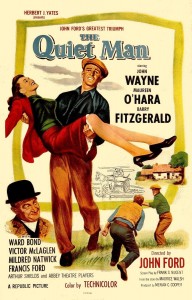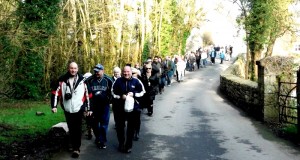The Quiet Man: 2013 Meta-Marketing Job-Creation Lessons from Ireland

You think that sounds weird?
How about a new tour entrance-fee to view the kitchen, the ingredients and the preparation of the menu items you just ate and paid for at Luigi’s Bella Grosso Italiano Restaurant—spiced with an autographed photo of and a few anecdotes about the chef and his kitchen dramas? Souvenir menus, extra charge. Tips for the newly hired kitchen tour guides optional.
Movie Meta-Marketing and Spin-Off Job Creation
On the face of it, that kind of “meta-marketing”—the marketing of services and/or goods about previously marketed (often, but not always, purchased) services and goods—does sound a tad odd, even humorous, as do the created jobs.
But it is, in fact, very serious—and very big—business. A form of follow-up merchandising, exemplified by “cross-sell” or “up-sell”, what I’m calling “meta-marketing” is a very big log for, in particular, already or still on-fire movies that create huge fan followings. In the travel business, this latter application of meta-marketing is called and analyzed as “film-induced tourism”.
Depending on the movie, those logs can burn for years, even decades—incandescently or merely as sentimental embers that flicker, before going utterly cold or somehow bursting into flame again.
The 1952 John Ford romcom classic, “The Quiet Man ” (its history and impact comprehensively reviewed in the Irish Examiner’s 2011 article, “King of Cong “), starring John Wayne, Maureen O’Hara and Barry Fitzgerald is a prime illustration of both meta-marketing and its durability.
It was, in part, filmed near and here (where I am as I write this) in the cozy village of Cong, Mayo County, Ireland (population in 2006 census, 150), but became and has remained a world-wide sentimental favorite, generating and logging tourism revenues and associated jobs for now more than 60 years (something most movies never do).
The spectacular Irish scenery alone may suffice to explain its enduring appeal. That’s how I ended up here—purely on the strength of a couple of hauntingly idyllic bowered and lush riverside scenes that remained embedded as a childhood mental snapshot for decades after I saw the movie with my parents when I was eight years old (the icky kissy-face romantic stuff never having registered in my child’s mind at that time).
Note: My childhood response to only the landscape draws some theoretical support from one cultural analysis: “Luke Gibbons [Professor of Irish Literary and Cultural Studies at the School of English, Drama and Media Studies, National University of Ireland] dramatically proposed that landscape as it has been represented in Irish cinema tended to play a leading role, to such an extent that it ‘upstaged’ the main characters and narrative themes in the construction of Ireland on the screen.” (“The Post-Colonial Landscape Aesthetic of The Quiet Man ” by Eammon Slater)
This suggests that some of the enduring meta-marketing of this film and others may be driven more by landscape, than by the cast or the story.
In any case, Jimmy Deenihan TD Minister for Arts, Heritage and the Gaeltacht, on launching the 80th anniversary exhibition of short-story author Maurice Walsh’s original drafts of ‘The Quiet Man’ this month, described the film as an Ireland tourism magnet: “Many visitors cite seeing ‘The Quiet Man’ as one of the reasons why they thought about coming to Ireland.” (Count me as one of them.)
‘The Quiet Man’ as Paradigm of Movie Meta-Marketing 1952-2013
As a paradigm meta-marketing case study, “The Quiet Man” (viewable in its colorful entirety on YouTube ) is a classic example of a long-term, if not also perpetual, job creator and revenue generator.
For example, on one crisp, low-season late-February morning during my current stay, “The Quiet Man” walking tour through Cong (which I joined as an observer) had 80 American tourists traipsing Cong’s otherwise “quiet village” streets. Conducted by local “Quiet Man” museum and gift shop proprietor, hostel owner and “Quiet Man” guidebook author Gerry Collins, the tour group seemed remarkably large, given the time of year.
Collins (front and right leading the “Quiet Man” Cong tour in the photo) told me that during the high summer season, his Cong Tourist Hostel grounds are packed chock-a-block with camping tourist tents and motorized campers, many there because of the movie and its local museum, the original story cottage, etc.
Despite the reportedly all-American tour group that I observed, it has recently been reported that 80% of “The Quiet Man” film festival and film tourist traffic is from Ulster, Northern Ireland. Gerry confirmed this, observing that, indeed, visitors from Northern Ireland rank first in numbers, followed by the rest of the U.K, the U.S. and “other” (including increasing numbers of Chinese and Japanese).
Over the decades, “The Quiet Man” has kept Collins’ Irish eyes smiling. In the Irish Examiner report, commenting on the impact of the recession on business, Collins is quoted as saying, “Many of us would have holes in our pants if it wasn’t for Maureen O’Hara. ‘The Quiet Man’ has done more for Cong than a thousand Fáilte Irelands [the “Welcome Ireland” National Tourism Development Authority of Ireland].”
True, Cong is also one of Ireland’s true sightseeing gems—what with its ancient abbey ruins, enchanting forests, stone-walled meadows and the renowned Ashford Castle Hotel (aerial view, below). So, it’s likely that Cong tourism will always flourish. But, then there’s the movie “meta-marketing” component of Cong tourism.
In 2011, the castle, silhouetted as the background of the film’s opening credits, offered “Quiet Man” packages commemorating the 60th anniversary. To fully savor the “Quiet Man” behind-the-scenes ambience, guests can stay in the rooms occupied by Wayne and O’Hara in 1951.
Cong’s ‘Quiet Man’ Meta-Marketing 2013 Moves
Indeed, six decades later, “The Quiet Man” is still making a lot of marketing noise to pump up Ireland’s and Cong’s tourist volume and revenues. On the heels of a 3-day “Quiet Man” festival staged August 24th-26th(2012)and attended by Dublin-born “Quiet Man” leading lady Maureen O’Hara, Cong is planning:
- to create an Irish version of the Hollywood walk-of-fame, complete with bronzed and mounted handprints of stars, including Irish actors, of course.
- to honor O’Hara with an unveiling of a life-sized statue of her and co-star John Wayne, as part of Cong’s contribution to the Irish national celebration, The Gathering Ireland 2013. “Cong’s “Quiet Man” Gathering will run from April 1st to October 31st.
The business revenue and job-creation implications should be obvious: Apart from “The Quiet Man” revenues generated by hotel, hostel and BB stays, bus tours, flights, souvenirs and memorabilia, there are the directly supported and generated jobs, e.g., in museums, gift-shops, “Quiet Man”-themed hotels, BBs, pubs, publications, DVD production and of course with group tours.
I don’t know whether the couple that arrived by helicopter at the Ashford Castle Hotel’s helipad were at all influenced by “The Quiet Man”, but, if they were, it would help explain why anyone would—even allowing for the unique, considerable charms of Cong and the Ashford Castle Hotel—pay $3,080 (€2,200) for two to fly (one hour) from Dublin to Cong (a figure quoted by the Dublin-based helicopter company). It would also vividly illustrate the power of meta-marketing.
The Evidence That Film Tourism Meta-Marketing Works
If there is any doubt about this meta-marketing power, look at the following 2009 study’s data, as but a small illustration of it:
- “Braveheart” (Mel Gibson, 1995), Wallace Monument, Scotland, 300% increase in tourism a year after release (plus me, last year)
- “Captain Corelli’s Mandolin” (starring Nicholas Cage, 2001), Cephalonia, Greece, 50% increase
- “Field of Dreams” (Kevin Costner, 1989), Dubuque County, Iowa, 35,000 visits in 1991 and steady increase “every year”
- “Harry Potter and…”, various locations in UK, increase of 50% or more in all filmed locations
- “Mission Impossible 2” (Tom Cruise, 2000), National Park, Sydney, 200% increase in 2000
As for the legs and future of the meta-marketing of “The Quiet Man”, in 2011, Patrick Luskin of Corrib Cruises, which operates cruises nearby, said, “It’s been a huge thing over the years. Every year since 1952 people would say it will only last another five years. But it hasn’t petered away. It has kept going.”
General Lessons of and for Meta-Marketing
Capitalizing on movies to create spin-off, secondary jobs and revenue is niche meta-marketing. But there are general principles it illustrates, applicable to meta-market job creation and money making in other arenas.
Here are some of the core considerations and principles:
- A meta-market can be created as a simple consequence of value-added information. For example, finding out about a locale’s physical, cultural (including artistic) or historical features may trigger an interest in it. In 1994, After watching “Roxanne” (1987) with Steve Martin, and having been struck by the incredible beauty of the location, I checked the credits, discovered it was Nelson, B.C., rented a car the next week, drove there and bought 31 acres of forested mountainside property overlooking Kootenay Lake (which, at that time, was much, much cheaper than you might imagine).
That was in terms of expense, probably very low-level meta-marketing, since consent to allow filming there probably cost Nelson little, compared to the likely meta-marketing film-induced benefits to the community and spin-off businesses/employees.
By providing follow-up information about a previously marketed service or product, a company can generate additional interest, revenue and jobs, e.g., by noting medical studies citing the prostate cancer prevention benefits of the antioxidant lycopene in already marketed tomato products, such as pizza sauce.
- A meta-market can be created through tribalism: Apart from the chance to visit the countryside, urban Ulster’s fascination with “The Quiet Man” may reflect national, clannish, regional, ideological or other pride.
Similarly, Super Bowl post-game analyses, merchandising, awards, etc., can intensify or create “tribal” loyalties among game fans, to the benefit of everyone in the marketing chain, all the way down to the stadium hot dog vendors.
- A meta-market can be created through skillful presentation of escapism: I suspect that much of the appeal of “The Quiet Man” is its casting of John Wayne as Rousseau’s “Noble Savage” (powerful, impulsive, all-natural, yet morally civilized), Maureen O’Hara as strong, yet feminine, and the romantic imagery it embodies, both behaviorally and in terms of its beautifully pristine, pastoral scenery.
In particular, the film offered escape from (1950s’) Puritanical constraint, dull (sub)urban scenery and humdrum, unexciting daily routine.
In soft confirmation of this, on the tour, I noticed that any playful allusions to the erotic connection between Wayne( or “Sean Thornton”, the character he portrayed) and Maureen O’Hara (“Mary Kate Danagher”) set the largely older group atwitter—which suggests some sort of momentary leakage and release of otherwise publicly unexpressed sexy feelings as holiday spice.
Of course, there are the escapist pleasures of Cong’s natural, architectural and historical charms—not to mention escapes from traffic jams, urban anomie and unsmiling big-city mall and subway crowds into the warm welcome Cong’s friendly residents offer.
Precisely the same effect characterizes the marketing of automobiles: After the cars are produced and sold through primary advertising-driven marketing of them, meta-marketing aboutthe cars kicks in, e.g., in the form of car and consumer magazine reviews, “Grand Theft Auto”-type computer games, and model cars for kids—supporting and creating revenues and jobs.
For kids too young to drive, these industries offer perfect forms of escapism from the tyranny of adults who withhold coveted drivers’ licenses from them.
As for driving to Cong and “Quiet Man” country, Irish car rental companies will gladly rent parents a vehicle that can perform double-duty…
…Perpetuation of parental tyranny and escapism for the whole family.

